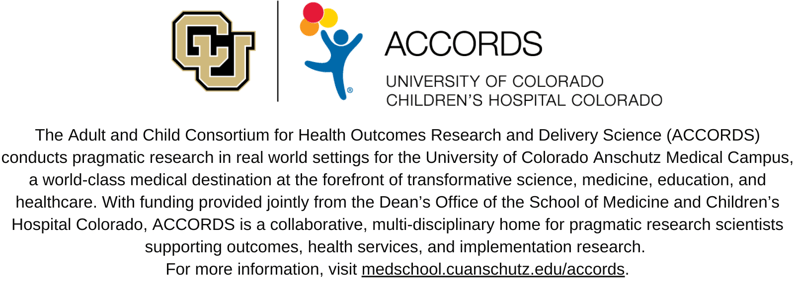How well-informed are patients? Before they make a major medical decision, do they know the impacts of that decision? How can healthcare providers improve a patient’s understanding of their condition, treatment options, and the benefits and risks of the medical decision before them?
“There is a driving hypothesis in our research,” says Dan Matlock, MD, MPH, director of Colorado Program for Patient Centered Decisions (CPPCD) and associate professor of geriatric medicine at the University of Colorado School of Medicine. “The hypothesis is that we often do things to people instead of with them.” Matlock’s passion behind his work with CPPCD is to help healthcare providers come alongside their patients and make decisions with them.
|
Dan Matlock, MD, MPH Associate Professor of Geriatric Medicine at CU-School of Medicine Director of the Colorado Program for Patient Centered Decisions at ACCORDS |
CPPCD, a nationally renowned program and part of the Adult and Child Consortium for Health Outcomes Research and Delivery Science (ACCORDS) at the University of Colorado (CU) School of Medicine, takes a broad view of decision-making between patients and providers. The team specializes in creating patient decision aids, most often visual aids in the form of booklets, videos, and websites, that provide information about treatment options for patients to consider and discuss with their health care providers. The goal is to increase patients’ knowledge of their medical condition and the risks and benefits of available treatments, and to empower them to become more involved in the decision-making process.
The Centers for Medicaid and Medicare Services (CMS) has mandated that all providers use a decision aid with patients for three specific procedures. Essentially, for Medicare to cover the cost of these certain procedures, it requires providers to review and discuss them with a patient using a decision aid. In October 2018, CMS released a decision memo, or National Coverage Determination, on implantable cardioverter defibrillator (ICDs). CPPCD’s decision aid (or Shared Decision Making tool) for ICD therapy is the only example referenced in the CMS memo (and is referred to three separate times).
Treating patients with ICDs was in fact the first instance where Matlock began to consider how to better collaborate in patient decision-making. When he was a geriatric fellow at the CU School of Medicine in 2007, Matlock was working with two elderly patients, each of whom had ICDs. In treatment conversations with them, he realized they were not fully aware of how their ICDs worked and the implications of having them.
"I realized that many of
these people had no idea
what they were getting into
with this treatment."
“I realized that many of these people had no idea what they were getting into with this treatment,” reflects Matlock. “These patients were totally uninformed about what was happening with the defibrillator—they were just told by their doctors that they needed theses ICDs to save their lives.” Interactions with these patients were the genesis for Matlock’s journey to improving the shared decision-making process.
“As doctors, we have all these cool toys and things we should do for the right patient, but the decision of whether or not to do those things should be consistent with people’s life goals and values,” says Matlock. “That's the passion behind all of this work is exploring how best to do that.”
Matlock became the head of CCPCD when he joined the university and ACCORDS in 2007. His team, consisting of several principle investigators and research assistants, has been successful in obtaining funding from many foundations as well as the National Institutes of Health (NIH), and the Patient Centered Outcomes Research Institute. With support from ACCORDS, CPPCD brings together multidisciplinary expertise in the development of materials, measurement of outcomes, and implementation into practice settings.
The CPPCD team has been working on the ICD decision aid since 2009 and is supported by the National Institutes on Aging and the Patient-Centered Outcomes Research Institute. Since January 2018, there have been 16,000 website visits and 11,000 downloads of CPPCD’s ICD videos and decision aid. Most of these are from users in the U.S., but users from Canada, the United Kingdom, France, and Germany all have very high session durations using the tool.
Since January 2018, there
have been 16,000 website
visits and 11,000 downloads
of CPPCD’s ICD videos
and decision aid.
“We have seen so many great tools that are developed and tested in a research setting but are never used in practice,” says Jocelyn Thompson, project manager for CPPCD. “We are so proud to see many of our tools being used in practice.”
The CPPCD team is constantly revising its decision tools based on updated research and user feedback. The group is currently studying how often providers are using the ICD decision tool and how patients rate its impact on preparing them for their treatment decision.
CPPCD has also created a decision aid for Atrial Fibrillation procedure, the second procedure CMS has mandated decisions tools for. CPPCD’s aid was created in collaboration with the American College of Cardiology and is designed for patients considering stroke prevention options for atrial fibrillation.
The third mandate CMS has made for decision aids is for lung cancer screening. CPPCD is currently working on a decision aid for this as part of a P50 grant. The tool is being launched in a clinical trial in the summer of 2021 in the High Plains Research Network—a network of rural primary care providers in the eastern plains of Colorado.
|
Larry Allen, MD, MHS Professor in Cardiology at CU-School of Medicine Co-Director of the Colorado Program for Patient Centered Decisions at ACCORDS |
Larry Allen, MD, MHS, co-director of CPPCD and professor in cardiology for the CU School of Medicine, helped start CPPCD out of a desire to perform research that would make a difference. “So much of what we do in research can feel like it just ends up on the shelf,” says Allen. “People talk about how academics sit in their ivory tower without much influence, and I think the work we do is a great example of research actually impacting peoples’ lives.”
The responsibility of informing patients weighs heavy on the CPPCD team. The decision tools they create may be a patient’s only source of discernable information on their procedure, making the tool’s design extremely important. “Heuristics, the shortcuts people use to make decisions, can be helpful or harmful,” says Allen, “so these tools need to be designed in a way that doesn’t create biases that are inappropriate.”
Allen has led much of the work on a decision aid for Left Ventricular Assist Devices (LVAD) for patients in severe heart failure. After a decade of work around development, effectiveness, and dissemination and implementation, this decision aid has been adopted by the majority of LVAD programs in the United States. CPPCD’s LVAD decision aid webpage clearly states the goal at the center of the team’s purpose in creating these tools, “Your values and goals are the most important factors in making a decision.”
Thompson, who also works primarily on the LVAD decision tool at CPPCD, has been involved in creating the decision tools with the team from start to finish. “From development to implementation, it's really exciting to see the evolution of these tools and the impact they can have on hospital systems, providers, patients and caregivers,” she says. “We've talked to many stakeholders from all of those groups who have had really difficult experiences with the shared decision-making process. Seeing how decision tools can help improve that and help supplement existing clinical encounters and conversations to make them more fruitful and effective has been really exciting.”
We hope we can use these tools
to nudge the culture to be a little
more patient-centered.
CPPCD has high hopes for its decision tools and their impact on medicine as a whole. “We hope we can use these tools to nudge the culture to be a little more patient-centered,” says Matlock. “Our goal is to use these tools to encourage providers to have just a little conversation about their patient’s goals and values, and hopefully these tools will help their medical choices align with those goals in the end.”
View all of CPPCD’s decision aids at www.patientdecisionaid.org.


.jpeg?width=203&name=dan-matlock-sq%20(1).jpeg)
.jpg?width=189&name=larry-allen-new-crop-(1).jpg)


